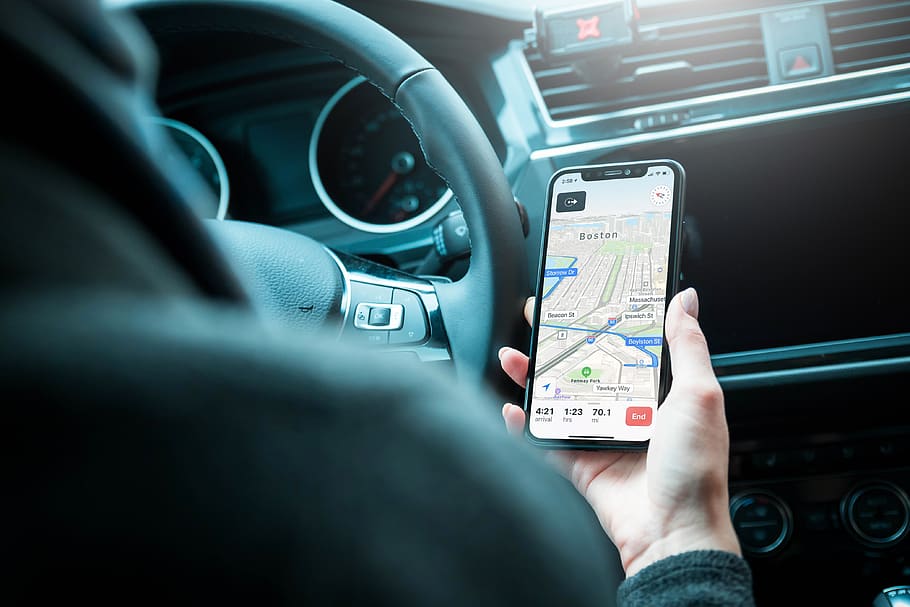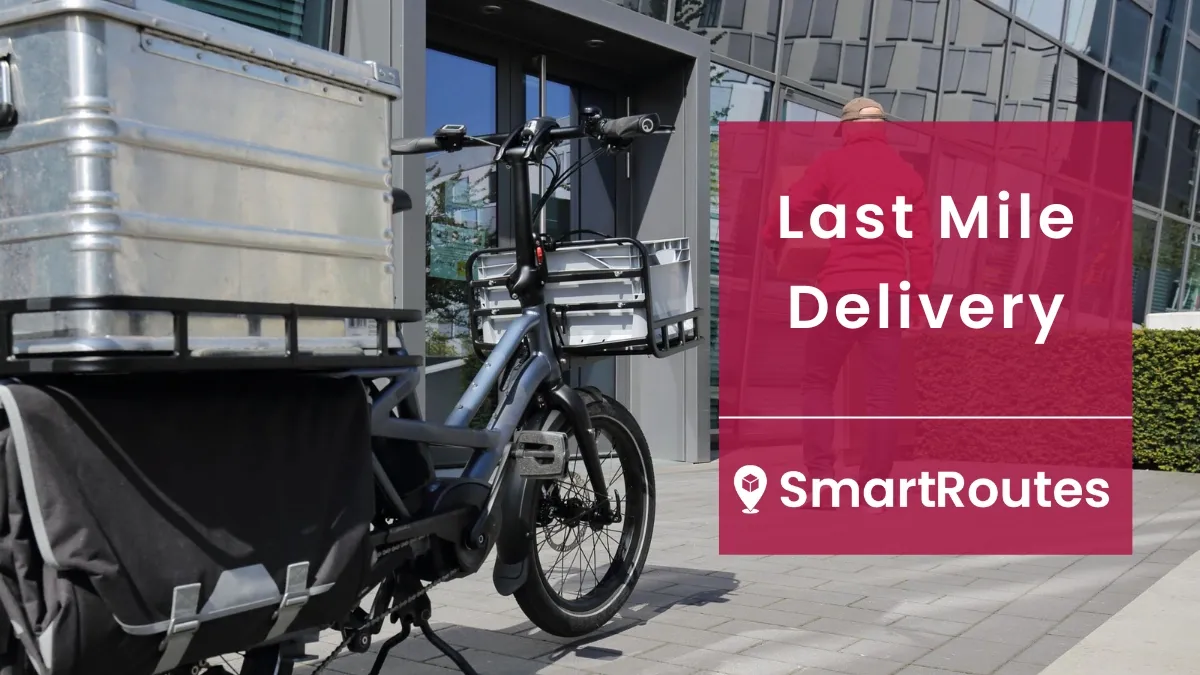Route Optimization: The Complete Guide
With route optimization the difference between success and failure in delivery operations we ask why people are still planning routes manually?
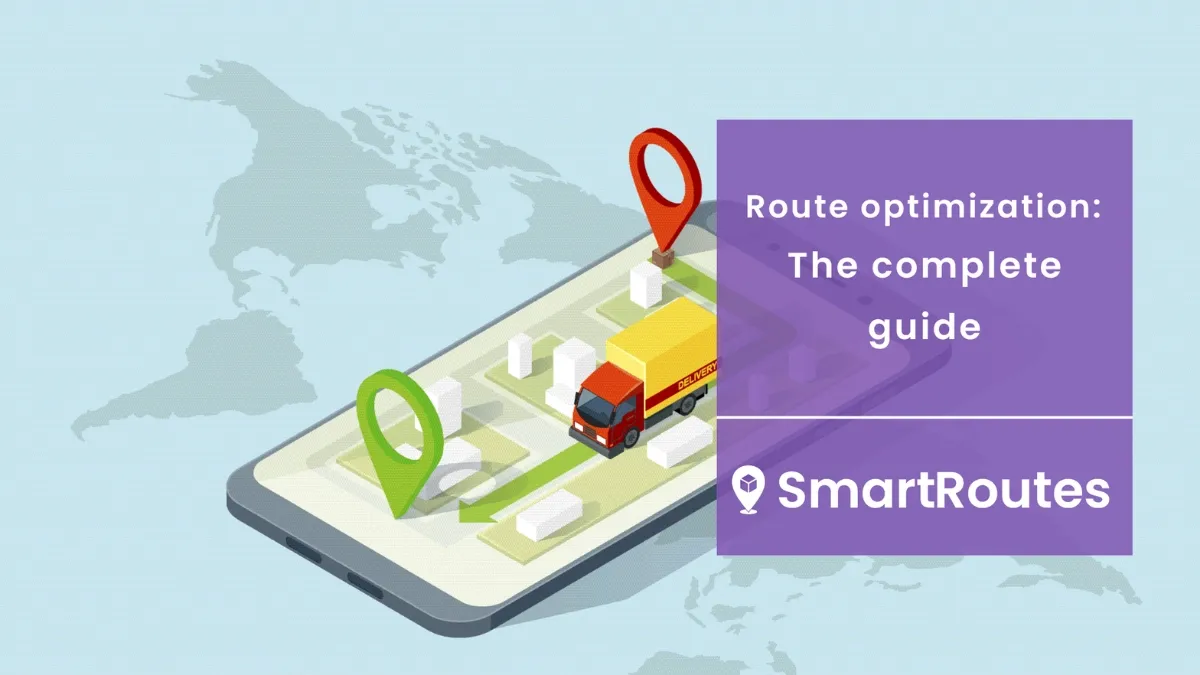
Route optimization is essential when your fleet has hundreds of clients to visit or delivery drops to make every week. The traditional method of planning these routes manually is not only time-consuming but also significantly less efficient compared to the use of specialized routing software. When considering the last mile makes up 53% of total shipping costs, with driver wages and fuel expenses being a large cause of this, it becomes evident that optimizing routes is critical for cost management.
By integrating route optimization software into your operational workflow, you introduce a level of precision and efficiency that manual planning simply cannot match.
In this blog, we are going to take a look at route optimization & how it works, how it compares to manual route planning, its myriad of benefits and some real-life examples of how it’s helped delivery teams.
Why can't I continue planning my routes manually?
Route Optimization: Real-life Examples
Benefits of Route Optimization
Industries that can Benefit from Route Optimization
How does Route Optimization Work?
What is Route Optimization?
Route optimization refers to the process of determining the most efficient routes for last mile deliveries. It is a strategic approach aimed at enhancing operational efficiency and reducing costs within a delivery management system. By carefully analyzing various factors, delivery route optimization enables businesses to efficiently fulfill orders and navigate the complexities of delivery logistics. For logistics and delivery teams, last mile route optimization serves as a vital component of their digital infrastructure. It provides a systematic method for managing the intricacies of delivery operations, ensuring timely and cost-effective service.
While route optimization is commonly associated with finding the quickest path between multiple stops, its scope extends far beyond speed alone. Modern software solutions consider a multitude of factors, including:
- Vehicle restrictions
- Delivery time windows
- Sequencing
- Delivery Zones
- Driver availability and skills
- Minimizing the number of turns & optimizing left-hand (or right-hand) turns
- And more!
The complexity of delivery route optimization becomes evident when considering the vast number of potential routes, each influenced by numerous variables. In this context, AI-driven solutions emerge as essential tools for navigating the complexities of modern delivery management.
SmartRoutes Route Optimization Software
Streamline your entire delivery process, all from one platform
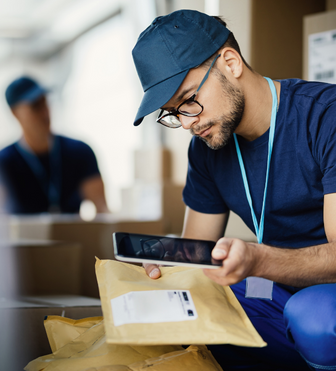
Why can't I continue planning my routes manually?
As your delivery operations expand, relying solely on manual route planning becomes increasingly impractical and inefficient. While manual planning might suffice for small-scale operations, it quickly becomes burdensome and error-prone with large-scale dynamic routing. At this stage, it's crucial to consider adopting more sophisticated route planning solutions to streamline your logistics processes and maximize efficiency, like a route optimization app.
Consider the following during your evaluation of manual route planning:
Inefficiency
Manual route planning may cause you to waste resources. For example, your drivers might be inadvertently adding extra mileage by backtracking unnecessarily, ultimately increasing fuel costs. This inefficiency could also lead to empty miles, driving up the overall cost per delivery. You might have more delivery drivers and vehicles on the road than necessary. By reassessing and streamlining your operations, you could potentially serve a larger customer base without the need for additional resources.
Poor Route Accuracy
Humans are prone to errors, and it's all too easy to overlook crucial factors in multi-stop routing like time windows and other specific conditions. The more intricate the requirements become, the greater the likelihood of human error creeping in. This, in turn, can lead to a decline in delivery accuracy, resulting in dissatisfied customers. Therefore, it's essential to pay close attention to detail and implement strategies to reduce the potential for human error, ensuring that delivery precision remains high and customer satisfaction levels are maintained.
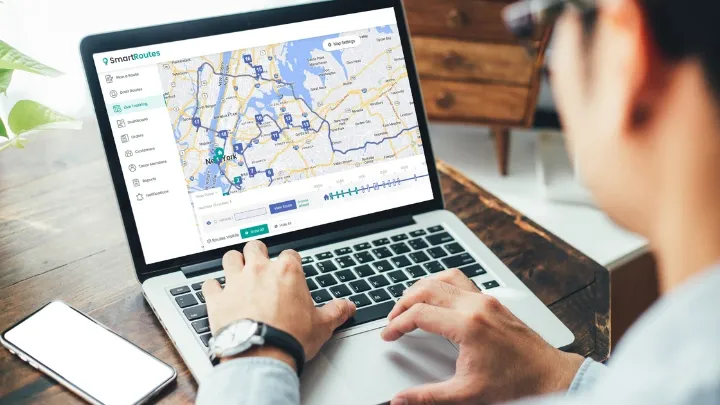
Impossible to Scale
Starting out, you may find it manageable to personally oversee route planning and communicate instructions to drivers. You might even excel at setting up delivery operations efficiently, and perhaps you even commit your customers' names to memory. However, as your business grows, relying solely on manual management becomes increasingly impractical and inefficient, consuming valuable time and resources. While starting small allows for a hands-on approach and personalized service, as your business expands, this method quickly becomes unsustainable. The time and effort required to manually handle every aspect of route planning and communication eventually outweigh the benefits. Recognizing the limitations of manual management becomes crucial for scalability.
Inflexible
In the dynamic landscape of delivery logistics, unforeseen circumstances are inevitable. Whether it's drivers falling ill or customers altering their orders at the last minute, the ability to adapt and re-optimize swiftly is paramount. Manual delivery scheduling offers limited flexibility to address sudden changes effectively. Consider the scenario where a driver needs to be rerouted midway through their shift due to unforeseen circumstances. Manual route scheduling lacks the agility needed to adjust promptly, often resulting in delivery delays and missed deadlines. By leveraging software solutions, with just a few clicks, routes can be recalculated, drivers reassigned, and schedules adjusted to accommodate changes in real-time.
Overdependence on Individual Knowledge
When key drivers depart and distribution managers transition out of the organization, the challenge arises: how does the company replenish the invaluable knowledge they carry? Without a robust system in place, the departure of experienced personnel could potentially disrupt operations and hinder growth. However, with the adoption of comprehensive delivery management systems, the organization can mitigate the impact of staff turnover. These systems serve as the central repository of knowledge, capturing and organizing critical operational data, best practices, and insights. To uphold this centralized knowledge management approach, implementing a user-friendly courier app becomes imperative. This app serves as the frontline tool for drivers, providing access to real-time data, optimized routes, and essential operational instructions. By equipping drivers with this technology, the organization maintains consistency and efficiency in delivery operations, irrespective of personnel changes.
Lack of Reporting Capabilities
Dependence on manual methods such as paper-based logs or spreadsheets for delivery planning severely limits the organization's ability to gain meaningful insights into delivery performance. The absence of technological support deprives the company of crucial data points, such as precise timestamps and locations of deliveries, accuracy rates in delivery sequencing, and adherence to delivery schedules. Employing delivery route optimization software unlocks a wealth of valuable data that can be leveraged for informed decision-making. By automating data collection and analysis, this software provides detailed reports encompassing critical metrics.
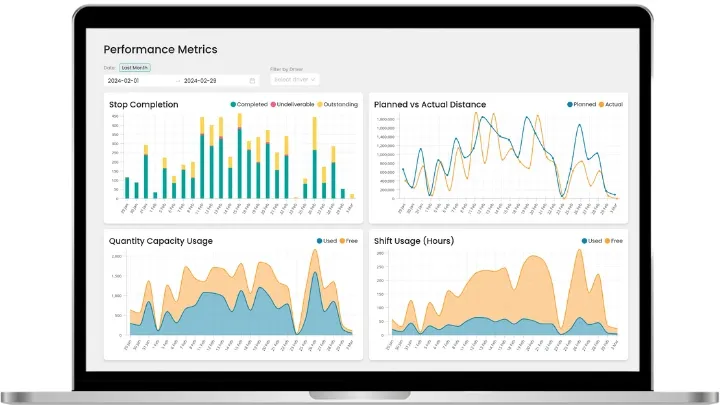
Route Optimization: Real-life Examples
Case studies on successful route optimization implementations have demonstrated significant cost savings and efficiency improvements for our clients across various industries. By leveraging advanced algorithms and real-time data analysis, they have been able to streamline their delivery processes, minimize fuel consumption, and reduce overall transportation time:
Logistics Route Planning: Transvalair
Transvalair is a Worldwide Logistics and Supply Chain Solutions provider. They offer comprehensive services ranging from packing and documentation to import handling and warehousing. Within their array of services lies Duo Delivers, a specialized 2-man home delivery service tailored specifically for commercial retailers, manufacturers, and e-commerce businesses. Duo Delivers stands out from other 2-man carriers due to its unwavering dedication to customer satisfaction and its ability to adapt seamlessly to clients' unique requirements.
How Route Optimization Transformed Their Delivery Operations
SmartRoutes' routing optimization software has revolutionized Transvalair's delivery operations, yielding substantial time savings through automated route planning. Utilizing the SmartRoutes app, the team at Transvalair can effortlessly input addresses directly or upload bulk addresses via Excel or Google Sheets, streamlining the route planning process. With just a simple click, routes are swiftly planned and optimized, factoring in vehicle-specific parameters such as time windows and constraints.
The platform enables the warehouse team to generate run sheets and labels seamlessly, facilitating more precise packing of delivery vans. Leveraging the map feature, the team can strategically organize orders into groups, further optimizing efficiency by grouping them based on postcodes.
By ensuring that delivery vehicles depart from depots fully loaded, the time drivers spend on the road per delivery is minimized, resulting in decreased fuel usage and lower fuel costs. This approach maximizes the number of deliveries drivers can complete per day. Additionally, well-organized routes contribute to a reduction in missed deliveries and deadlines, bolstering customer relationships and fostering opportunities for repeat business.
Transvalair saw the following improvements:
- Achieved comprehensive visibility into their delivery operations
- Implemented automated planning of delivery routes and benefits from more efficient routing
- Empowered individual customers to confirm or update booking slots via SMS notifications
- Established a label system to enhance warehouse organization
- Provided businesses with access to a tracking portal for real-time updates on order status
“We needed a modern solution, one making use of new technology available on market. SmartRoutes provided just that and is continuously getting better. Our teams favourite feature at present is the Online Customer Delivery Booking Portal. We send our customers a proposed delivery date by SMS/E-Mail with a link to confirm or select a delivery date of their choice. The system then gets updated immediately with the customers choice and our team has instant visibility of this change. This feature has saved our team hours of manual work.”
- Roberto Bejar, Transvalair
The Results
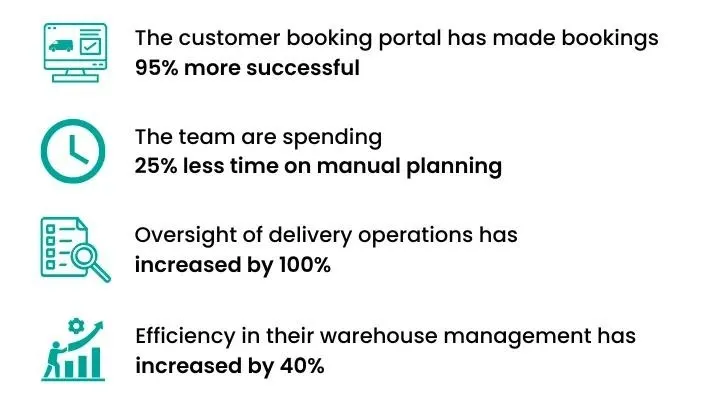
Grocery Home Delivery: Musgrave
Musgrave stands as Ireland's premier food retail, wholesale, and food service company, boasting a rich legacy of 146 years in food and brand innovation. As one of Europe's most successful family-owned enterprises, Musgrave caters to the dietary needs of one in three individuals in Ireland daily. Their extensive portfolio comprises 11 leading food and beverage brands, including SuperValu, Centra, Frank and Honest, and Musgrave MarketPlace, all crafted to address the evolving preferences of modern consumers.
Collaborating closely with local entrepreneurs embedded within the communities they serve, Musgrave ensures its brands resonate with and meet the diverse needs of shoppers. SmartRoutes has partnered with ten of Musgrave's SuperValu stores across Dublin, Limerick, Waterford, and Kilkenny, facilitating grocery home delivery services.
How Route Optimization Transformed Their Delivery Operations
Through the integration of SmartRoutes route planning software, Musgrave has streamlined the cumbersome task of route planning, significantly reducing administrative burdens. The software automatically generates and allocates routes to drivers based on customer-specified time windows, locations, and vehicle capacity requirements. Consequently, orders are efficiently grouped for loading into delivery vans, enhancing overall organization within the area.
With vehicles departing from the depot fully loaded, operational efficiency and productivity have soared. Routes are seamlessly transmitted to drivers via the Drivers Mobile App, enabling them to commence their day promptly by delivering orders to customers without delay. This efficient workflow ensures that drivers can focus their efforts on serving customers rather than dedicating precious morning hours to route selection and organization.
Musgrave saw the following improvements:
- Enhancing the delivery experience for their customers.
- Gaining increased control and visibility into delivery operations.
- Substantially decreasing the time dedicated to manual route planning.
- Ensuring deliveries were consistently fulfilled within selected delivery windows.
The Results
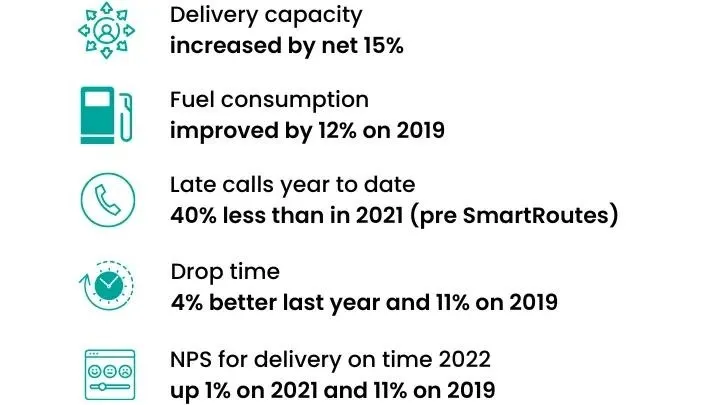
Benefits of Delivery Route Optimization
Route planning and optimization is tough work, no question.
- Getting the maximum return from your drivers’ work and fleet is hard
- Scheduling routes is nearly impossible once you go over a certain threshold of stops and vehicles
- The cost of deliveries in terms of fuel and wages can skyrocket and is not something customers feel obliged to pay for
- Missed deliveries and the uncertainties of last mile can cost your business
If you use delivery route software however you can counteract these challenges and reap the benefits:
1. Improve Overall Delivery Efficiency
Last mile delivery route optimization doesn't just streamline operations; it fundamentally transforms the efficiency of your delivery process. By strategically planning and organizing routes, you empower your drivers to navigate through their schedules with greater ease and precision, leading to remarkable improvements in overall efficiency. Consider this: route optimization can yield a staggering reduction in the cost per delivery, slashing expenses by up to 33%. This substantial decrease directly translates into significant savings for your business. It also helps to accelerate delivery times. A study revealed that 48% of consumers prefer faster delivery services.
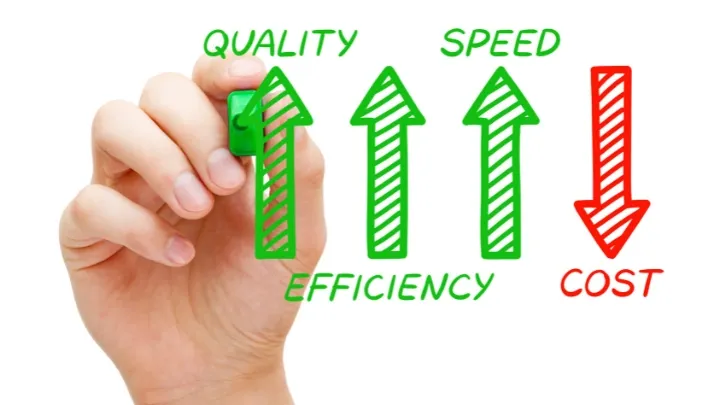
In essence, optimizing routes isn't just about making incremental improvements; it's about revolutionizing the way your delivery operations function. It's about maximizing efficiency, minimizing costs, and unlocking untapped potential for growth and scalability.
2. Significantly Reduce Cost per Delivery
Through the implementation of more strategic routes, you can maximize the productivity of your drivers' working hours. This optimization allows you to achieve more deliveries within the same timeframe, effectively leveraging existing costs such as driver wages, fuel expenses, and fleet maintenance.
By accomplishing a greater number of deliveries with the same resources, you inherently reduce the overall cost per delivery, making your delivery operations more cost-effective and profitable.
Also, with 36% of consumers abandoning orders due to excessively high shipping costs, lowering your cost per delivery provides an opportunity to transfer savings to the consumer.
3. Increase Driver Capacity
By optimizing routes and implementing efficient vehicle utilization strategies, you can effectively scale your operations without the need for additional resources. One key aspect of this optimization involves ensuring that vehicles leave depots fully loaded, a process facilitated by setting vehicle capacities. This approach maximizes the number of deliveries that drivers can complete without the need for return trips to the depot, thereby increasing their overall capacity.
You can use route optimization for maximizing driver productivity - by guaranteeing that routes are meticulously planned and optimized, drivers can make the most of their working hours. They can navigate their routes without unnecessary detours or backtracking, ensuring that they efficiently complete deliveries without revisiting stops later in the day. This proactive approach not only enhances driver productivity but also contributes to the seamless execution of delivery operations, allowing your team to handle increased volumes without compromising on efficiency or service quality.
4. Happier Customers
Accurate time windows provided through route optimization are very important for customers as it allows them to better plan their schedules accordingly and ensure they're available to receive their orders promptly. As well as that, with GPS driver tracking typically integrated into optimized routes, customers are able to monitor their package's progress in real-time via a convenient online tracking portal. This transparency instills confidence and reassurance, enhancing the overall delivery experience.
Also, proactive customer notifications with accurate ETAs play a pivotal role in minimizing missed deliveries, by keeping customers informed every step of the way. By receiving timely updates regarding their delivery status, customers are less likely to encounter delays or inconvenience, fostering a positive impression of your service and improving customer retention. Surveys show that a whopping 40% of shoppers consider online delivery service reviews before making purchasing decisions, emphasizing the crucial role of customer feedback in shaping buying behaviors.
5. Better Load Balancing between Drivers
Intelligent route optimization tools provide dispatch managers with the capability to distribute workloads more equitably among drivers, enhancing overall efficiency and fairness in scheduling. By leveraging these tools, dispatch managers can effortlessly balance schedules and allocate order quantities with just a simple click, ensuring that no driver is overburdened while others remain underutilized. This streamlined approach to workload management not only maximizes productivity but also promotes a more balanced and harmonious work environment for your delivery team.
Additionally, geographical zones can be established for drivers, eliminating unnecessary trips to depots and reducing fuel consumption and wear and tear on vehicles. This strategic setup allows drivers to operate within designated areas, minimizing transit times and optimizing route efficiency. By minimizing unnecessary travel, you not only conserve resources but also enhance the overall sustainability of your operations.
Given the current shortage of drivers, it's imperative to make these considerations to alleviate the strain on your workforce and ensure fair and equitable distribution of work. By implementing intelligent load balancing strategies, you not only optimize operational efficiency but also foster a supportive working environment that promotes employee satisfaction and retention.
6. Re-Optimize Routes on the Fly
While it's inevitable that unforeseen circumstances arise while out on the road, what truly matters is the ability to swiftly adapt to these changes. This is where dynamic route optimization proves invaluable. Despite meticulous planning, external factors such as road closures, traffic congestion, or sudden changes in customer availability can disrupt already optimized routes. In such instances, the ability to make quick adjustments and re-optimize plans in real-time becomes essential.
SmartRoutes intuitive platform allows dispatch managers to easily modify routes on the fly, taking into account real-time updates and unforeseen events. Whether it's adding new stops, rerouting drivers, or adjusting delivery priorities, SmartRoutes empowers users to respond swiftly to changing circumstances, ensuring that deliveries remain on track and disruptions are minimized.
The ability to re-optimize routes on the fly is not just advantageous—it's imperative. By leveraging dynamic route optimization capabilities, businesses can adapt to evolving situations with agility and precision, ultimately enhancing operational efficiency and customer satisfaction.
Industries that can Benefit from Route Optimization
1. Third-party Logistics
Managing large order volumes and numbers of different drivers requires a very efficient route optimizing model. Reporting back to clients on deliveries and establishing clear proof of delivery requires a total delivery management solution.
Industry Pain Points:
- Extensive geographical coverage poses logistical challenges for vehicle routing.
- Managing large fleets complicates fleet management and coordination.
- Overtime costs can eat into profits.
- High turnover rates among drivers can disrupt operations.
- Lack of oversight of drivers' activities and performance.
- Increasing customer demands for real-time tracking and updates.
- Compliance with regulations and industry standards.
- Limited visibility into delivery operations and performance metrics.
What Routes Optimization does to Solve these Issues:
- Long routes are optimized to accommodate driver availability, shift times, and break times while ensuring compliance with regulations.
- Load balancing ensures that workloads are distributed evenly among drivers and vehicles, maximizing efficiency and minimizing overtime costs.
- Real-time tracking and monitoring capabilities provide visibility into driver activities, allowing for proactive management and intervention when necessary.
- Automated reporting functionalities streamline the process of generating delivery reports and establishing proof of delivery, enhancing transparency and accountability for both clients and internal stakeholders.
2. Food and Meal Prep Delivery
In the realm of food and meal prep delivery services, customer satisfaction hinges not only on the quality of the food but also on the speed and transparency of delivery. Real-time route optimization plays a crucial role in meeting these expectations, as customers now demand live tracking of their orders. Additionally, including order packaging slips as part of the delivery management solution is essential for ensuring a seamless customer experience.
Industry Pain Points:
- Ensuring timely and efficient delivery while maintaining food quality and freshness.
- Managing a diverse range of delivery locations, including residential addresses, office buildings, and commercial establishments.
- Minimizing delivery delays and order errors to uphold customer satisfaction.
- Balancing order volumes and delivery timeframes during peak hours and busy periods.
- Managing food safety and compliance with regulatory standards during transit.
- Ensuring clear communication with customers regarding delivery updates and any potential issues.
What Routes Optimization does to Solve these Issues:
- Real-time route optimization algorithms factor in variables such as delivery windows and order priorities to ensure timely and efficient delivery while minimizing delays and errors.
- Live tracking capabilities allow customers to monitor the progress of their orders in real-time, enhancing transparency and providing peace of mind.
- Optimized routing and scheduling algorithms enable drivers to navigate efficiently between delivery locations, maximizing productivity and minimizing idle time.
- Enhanced communication features, such as automated SMS notifications and delivery status updates, keep customers informed throughout the delivery process.
- Compliance with food safety regulations is facilitated through route optimization solutions that prioritize efficient delivery routes while ensuring proper handling and storage of food items during transit.
3. Retail and eCommerce
Customer expectations around home delivery have grown massively on account of Amazon Prime and other same-day delivery services. Also, customers expect a high quality of delivery service with quality packaging and delivery people to embody the brand experience for them. Retail globally is moving to online and so the delivery experience is the only face to face interaction the customer has with the brand.
Industry Pain Points:
- Meeting evolving customer demands for fast and reliable home delivery services.
- Ensuring consistent quality and professionalism in the delivery experience to uphold brand reputation.
- Managing complex delivery logistics, including order fulfillment, scheduling, and tracking.
- Balancing cost-efficiency with the need to provide premium delivery services.
- Addressing last-mile delivery challenges, including urban congestion and residential accessibility.
- Managing returns and exchanges efficiently to maintain customer satisfaction.
What Routes Optimization does to Solve these Issues:
- Premium packaging and delivery options can be integrated into the delivery management solution, allowing retailers to offer value-added services that enhance the customer experience and reinforce brand loyalty.
- Integration with eCommerce platforms enables seamless order processing and tracking, providing customers with visibility into the status of their orders from purchase to delivery.
- Advanced analytics provide insights into delivery performance, allowing retailers to identify areas for improvement and optimize operations for greater efficiency and cost-effectiveness.
- Enhanced communication features, such as automated notifications and delivery updates, keep customers informed throughout the delivery process, enhancing transparency and reducing uncertainty.
4. Pharmaceuticals & Medical Equipment
In the realm of healthcare and medical equipment delivery, ensuring timely and reliable service is paramount. Whether it involves delivering medical equipment or facilitating medical services, healthcare professionals rely on clear and accurate arrival times to effectively manage patient care. Establishing accurate estimated times of arrival (ETAs) and providing clear information about the expected delivery can be facilitated through customer live-tracking portals. Additionally, enabling drivers and delivery teams to provide live updates via SMS helps keep patients informed throughout the delivery process.
Industry Pain Points:
- Ensuring timely delivery of critical medical equipment and supplies to healthcare facilities and patients.
- Providing accurate ETAs and clear communication to minimize disruptions.
- Managing complex delivery logistics, including adherence to healthcare regulations and standards.
- Ensuring the safe handling and transportation of sensitive medical equipment, pharmaceuticals, and supplies, which may require specialized conditions such as chilled vans for certain pharmaceuticals.
What Routes Optimization does to Solve these Issues:
- Customer live-tracking portals provide customers with visibility into the status of their deliveries, including accurate ETAs and real-time updates on the delivery progress.
- Notifications via SMS/email enable drivers and delivery teams to provide live updates, keeping customers informed throughout the delivery process and ensuring a seamless and transparent experience.
- Streamlines the delivery process, reducing administrative burden and ensuring seamless coordination between suppliers and recipients.
5. Bulky Goods eg. Furniture
In industries dealing with bulky goods such as furniture, optimizing delivery routes is crucial to mitigate fuel costs and enhance operational efficiency. Large vehicles used in transporting these goods tend to consume significant amounts of fuel, making it imperative to minimize unnecessary driving. Route optimization, coupled with driver tracking, plays a pivotal role in ensuring cost-effective transportation. Additionally, maximizing vehicle capacity is essential to optimize resource utilization.
Industry Pain Points:
- Lack of proof of delivery can lead to costly disputes regarding the quality of items delivered.
- Maximizing vehicle capacity to minimize fuel and operational costs.
- Time-consuming manual notification of delivery schedules to customers.
- Inadequate time allocation per stop, particularly for bulky deliveries, can disrupt the entire day's delivery schedule.
What Routes Optimization does to Solve these Issues:
- Implementing a customer booking portal allows customers to schedule delivery timeslots that suit their convenience, reducing the likelihood of missed deliveries and disputes.
- Route optimization algorithms optimize delivery routes to minimize fuel consumption and reduce unnecessary driving, thereby mitigating operational costs.
- Driver tracking capabilities enable real-time monitoring of driver locations and activities, facilitating better coordination and management of delivery schedules.
- Automated notification systems streamline the communication process by sending timely updates to customers regarding their delivery schedules, reducing the need for manual phone calls and saving time.
- Adequate time allocation per stop is ensured through optimized route planning, allowing sufficient time for bulky deliveries without compromising the overall efficiency of the delivery schedule.
6. Field services
Field services, characterized by last-minute changes and time-sensitive demands, require efficient route planning to ensure timely service delivery. With multiple stops under time pressure each day, optimizing and re-optimizing routes can lead to cost savings and improved service quality for end customers.
Industry Pain Points:
- Managing last-minute changes to service schedules and multiple stops under time constraints.
- Meeting end customers' time-sensitive demands and expectations for fast service arrival.
- Optimizing route planning to minimize travel time and maximize service coverage.
- Balancing workload distribution among service technicians to maximize productivity and efficiency.
- Ensuring effective communication between service teams and customers regarding service appointments and updates.
What Routes Optimization does to Solve these Issues:
- Route optimization algorithms streamline the process of planning and re-optimizing service routes, enabling service technicians to navigate efficiently between multiple stops while meeting time-sensitive demands.
- Real-time tracking and monitoring capabilities allow dispatch managers to monitor service technicians' locations and activities, facilitating better coordination and management of service schedules.
- Automated notification systems keep customers informed about service appointments and updates.
- Advanced analytics provide insights into field service performance, allowing organizations to identify areas for improvement.
7. Waste Collection
Waste collection is a critical industry that can greatly benefit from route optimization to streamline operations and improve efficiency. Without an effective route optimization solution in place, waste collection companies may face various challenges in managing their operations.
Industry Pain Points:
- Inefficient routing leading to increased fuel consumption and operational costs.
- Difficulty in optimizing collection schedules to ensure timely and effective waste removal.
- Managing complex routes with multiple stops and varying waste disposal requirements.
- Balancing workload distribution among waste collection workers to maximize productivity.
What Routes Optimization does to Solve these Issues:
- Real-time tracking and monitoring capabilities enable waste collection companies to monitor vehicle locations and activities, allowing for better coordination and management of collection schedules.
- Automated notification systems keep customers informed about collection schedules and any changes or delays, improving communication and customer satisfaction.
- Advanced analytics provide insights into waste collection performance, allowing companies to identify areas for improvement and optimize resources for greater efficiency and cost-effectiveness.
- Optimizing routes to reduce fuel consumption and carbon emissions, helps waste collection companies minimize their environmental impact and comply with regulations.
Other Industries:
- Newspaper
- Couriers
- Agri & Dairy
- Supermarket & Grocery
- Electric and Large Home Appliances
- and much much more!
How does Route Optimization Work?
The best route optimization software takes into account two distinct data sets and merges them to create the most efficient route for a driver.
- The first data set is a mix of multiple travel time data sets that are collected by GPS tracking organizations like Google Maps. These data sets learn from millions of vehicles that typically take routes to understand the fastest way to navigate between points on a map.
- The second data set encompasses specific parameters set by the route creator. This includes factors such as designated stops along the route, time windows for deliveries, vehicle sizes and limitations, road tolls, and other preferences.
By merging these elements and processing billions of potential variations in a matter of seconds, SmartRoutes produces an optimized route. While the resulting route may sometimes differ from what a person would manually create, it consistently outperforms human-generated routes in terms of efficiency and time-saving.
Looking for Delivery Route Optimization?
If you're looking for the best route optimization app to optimize your delivery processes and streamline your operations, SmartRoutes is here to help. With our route optimization solution, you can unlock the potential for significant cost savings and efficiency gains.
To experience the benefits of route optimization firsthand, we invite you to take advantage of our 7-day free trial. During this trial period, you'll have the opportunity to see how SmartRoutes can transform your delivery operations and improve your bottom line.
Frequently asked questions
1. What is route optimization in last mile delivery?
Route optimization is a strategic process that utilizes advanced algorithms and technology to find the most efficient and cost-effective way to navigate a sequence of stops. It is commonly applied in logistics, transportation, and field services to streamline routes for vehicles, delivery personnel, or service technicians. The goal is to minimize travel time, reduce fuel consumption, and enhance overall operational efficiency.
2. What is the difference between route planning and route optimization?
While route planning involves manually charting a course from one point to another, route optimization employs algorithms and technology to dynamically adjust routes based on various factors such as driver skills and availability, delivery constraints, and vehicle capacities. Route planning is typically a static process, whereas route optimization continuously refines and updates routes to maximize efficiency and cost-effectiveness.
3. How do you optimize delivery routes?
Optimizing delivery routes involves analyzing various factors such as delivery locations, time windows and vehicle capacities. Advanced route optimization software uses algorithms to calculate the most efficient sequence of stops, minimizing travel time and fuel consumption while adhering to delivery constraints. Additionally, real-time data integration allows for dynamic adjustments to routes based on changing conditions, ensuring optimal efficiency.
4. What are the benefits of routing optimization?
Route optimization offers several key benefits for businesses. Firstly, it reduces operational costs by minimizing fuel consumption and vehicle wear and tear. Secondly, it enhances productivity and efficiency by optimizing schedules and reducing unnecessary travel time. Improved route planning also leads to enhanced customer satisfaction through accurate and timely deliveries or service visits. In summary, businesses adopting route optimization experience cost savings, increased operational efficiency, and improved customer service.
5. What factors should be considered for effective route optimization?
The key elements of the best route optimization software for delivery businesses include real-time data, vehicle capacity to maximize load efficiency, delivery or service windows to meet time constraints, and any specific constraints or requirements unique to the business. The integration of these factors through advanced algorithms ensures that the optimized route is not only efficient but also practical and feasible within the given operational context.
6. Can route optimization software integrate with existing systems and applications?
Yes, route optimization software is designed to seamlessly integrate with existing systems and applications. These solutions often provide APIs (Application Programming Interfaces) that facilitate integration with transportation management systems, CRM (Customer Relationship Management) software, and other relevant platforms. This integration ensures a smooth flow of data, allowing businesses to leverage route optimization within their existing operational frameworks without major disruptions.
If you enjoyed this blog, you might also be interested in:
